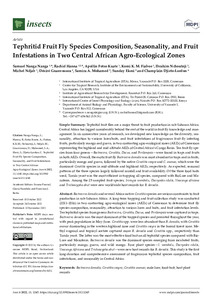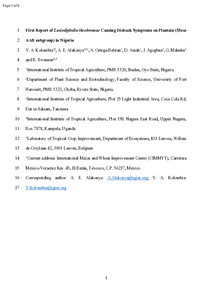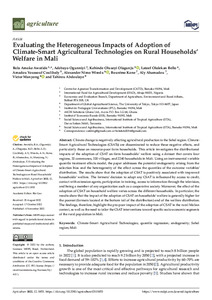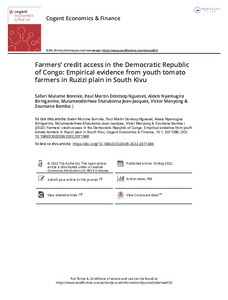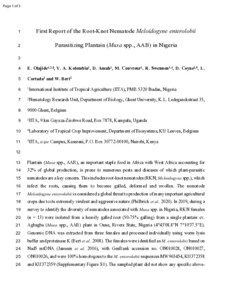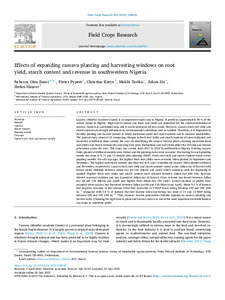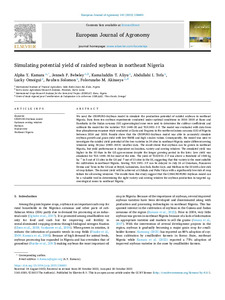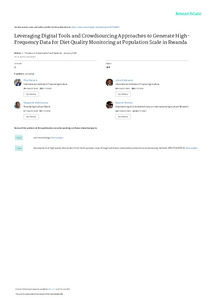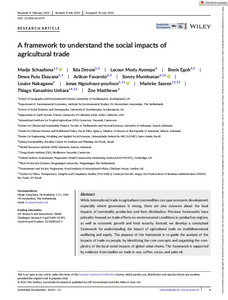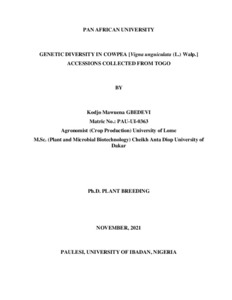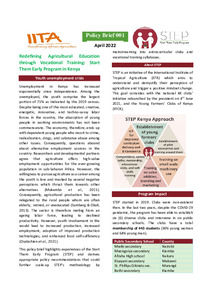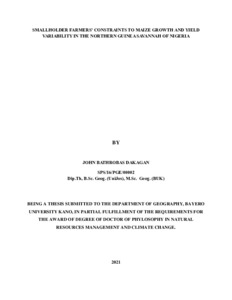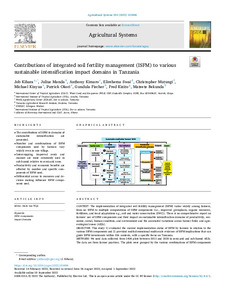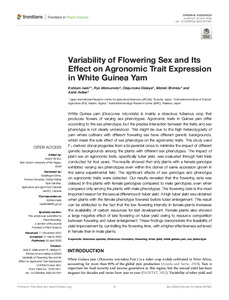Welcome to the International Institute of Tropical Agriculture Research Repository
IITA Bibliography System: Recent submissions
Now showing items 721-740 of 8099
-
Tephritid fruit fly species composition, seasonality, and fruit infestations in two central African agro-ecological zones
(2022-11-13)Bactrocera dorsalis and several Africa-native Ceratitis species are serious constraints to fruit production in sub-Saharan Africa. A long-term trapping and fruit collection study was conducted (2011–2016) in two contrasting agro-ecological zones (AEZs) of Cameroon to determine fruit fly species composition, seasonality, attraction to various lures and baits, and fruit infestation levels. Ten tephritid species from genera Bactrocera, Ceratitis, Dacus, and Perilampsis were captured in traps. Bactrocera ... -
Evaluating the heterogeneous impacts of adoption of climate-smart agricultural technologies on rural households' welfare in Mali
(2022-11-04)Climate change is negatively affecting agricultural production in the Sahel region. Climate-Smart Agricultural Technologies (CSATs) are disseminated to reduce these negative effects, and particularly those on resource-poor farm households. This article investigates the distributional impacts of the adoption of CSAT on-farm households’ welfare using a dataset that covers four regions, 32 communes, 320 villages, and 2240 households in Mali. Using an instrumental variable quantile treatment effects ... -
Farmers' credit access in the Democratic Republic of Congo: empirical evidence from youth tomato farmers in Ruzizi plain in south Kivu
(2022)This article assesses the opinions of youth tomato growers on the accessibility of agricultural credit and factors that influence the accessibility in the Democratic Republic of the Congo (DRC). Data originated from a household survey for the 2019/2020 farming season. We interviewed 218 youth tomato growers from 6 horticulture production zones in the South-Kivu, eastern DRC. The result reveals a low rate of 20.6% on accessing agricultural credit among tomato growers. The topmost nature of agricultural ... -
Comparative analysis of variation in African Bambara groundnut [Vigna subterranea (L) Verdc.] landraces assessed through seed traits
(2022-11)Bambara groundnut [Vigna subterranea (L.) Verdc.] originated from the African continent and plays social-economic roles in regions where it is consumed. This study examined 297 landraces of African Bambara groundnut from four African regions (West, Central, East, and Southern) to estimate the extent of diversity in each population, identify useful seed traits for differentiation in the population and estimate association among seed quantitative traits using eight qualitative and seven quantitative ... -
Cassava-maize intercropping systems in southern Nigeria: radiation use efficiency, soil moisture dynamics, and yields of component crops
(2022-07)Efficient utilization of incident solar radiation and rainwater conservation in rain-fed smallholder cropping systems require the development and adoption of cropping systems with high resource use efficiency. Due to the popularity of cassava-maize intercropping and the food security and economic importance of both crops in Nigeria, we investigated options to improve interception of photosynthetically active radiation (IPAR), radiation use efficiency (RUE), soil moisture retention, and yields of ... -
Understanding changes in cassava root dry matter yield by different planting dates, crop ages at harvest, fertilizer application and varieties
(2022-12-23)Cassava is a perennial crop that can adapt to periods of drought at different times in a growing season, which permits scheduling planting and harvest to develop production systems supplying roots continuously. However, farmers plant and harvest cassava at the onset of rains which creates glut and results in unattractive root prices. Thus, farmers need to understand how cassava varieties respond to different planting dates and crop ages at harvest to be able to use opportunities in income generation ... -
Effects of expanding cassava planting and harvesting windows on root yield, starch content and revenue in southwestern Nigeria
(2022-10-01)Cassava (Manihot esculenta Crantz) is an important staple crop in Nigeria. It provides approximately 80 % of the caloric intake in Nigeria. High starch content and fresh root yields are important for the commercialization of cassava. Cassava is a perennial crop, and it can be produced all year round. However, cassava fresh root yield and starch content are strongly influenced by environmental conditions such as rainfall. Therefore, it is important to identify planting and harvest periods to attain ... -
Simulating potential yield of rainfed soybean in northeast Nigeria
(2023-01)We used the CROPGRO-Soybean model to simulate the production potential of rainfed soybean in northeast Nigeria. Data from ten soybean experiments conducted under optimal conditions in 2016–2018 at Kano and Dambatta in the Sudan savanna (SS) agroecological zone were used to determine the cultivar coefficients and calibrate the model for the varieties TGX 1448–2E and TGX1951–3 F. The model was evaluated with data from four phosphorous response trials conducted at Zaria and Doguwa in the northern ... -
Leveraging digital tools and crowdsourcing approaches to generate high-frequency data for diet quality monitoring at population scale in Rwanda
(2022-01-07)Diet quality is a critical determinant of human health and increasingly serves as a key indicator for food system sustainability. However, data on diets are limited, scattered, often project-dependent, and current data collection systems do not support high-frequency or consistent data flows. We piloted in Rwanda a data collection system, powered by the principles of citizen science, to acquire high frequency data on diets. The system was deployed through an unstructured supplementary service data ... -
A framework to understand the social impacts of agricultural trade
(2022-08-30)While international trade in agricultural commodities can spur economic development especially where governance is strong, there are also concerns about the local impacts of commodity production and their distribution. Previous frameworks have primarily focused on trade effects on environmental conditions in production regions, as well as economic growth and food security. Instead, we develop a conceptual framework for understanding the impact of agricultural trade on multidimensional wellbeing ... -
Access to finance and rural youth entrepreneurship in Benin: Is there a gender gap?
(2022-01-27)Rural entrepreneurship is an important employment generation intervention for the fast-growing young labour force in developing countries. Many bottlenecks including access to finance impede rural youths from performing in their new ventures. This paper examines the impact of access to finance on rural youths' entrepreneurship in Benin using data from the second wave of the School-To-Work Transition Survey, involving over 900 youths. The paper employs the endogenous switching regression technique, ... -
Genetic diversity in cowpea [Vigna unguiculata (L.) Walp.] accessions collected from Togo
(Pan African University, 2021-11)Cowpea is one of the most widely grown legumes in Togo for its grains and leaves, which are used both as food and feed. Despite its importance in the nutrition and economic life of the people, bulk of the varieties grown in Togo are landraces. Genetic improvement of crops requires the presence of heritable genetic variation. However, there is hardly any information on the extent of variability among cultivated cowpea in Togo. This study was carried out to assess the phenotypic and molecular diversity ... -
Redefining agricultural education through vocational training: Start Them Early Program in Kenya
(International Institute of Tropical Agriculture, 2022-04) -
Smallholder farmers' constraints to maize growth and yield variability in the northern guinea savannah of Nigeria
(Bayero University Kano, 2021)Maize yield has been on the decline on smallholder farms, where the bulk of maize for different uses is produced in the Northern Guinea Savannah of Nigeria. This study analyzed smallholder farmers‘ constraints to maize growth and yield variability in the Northern Guinea Savannah (NGS) of Nigeria for yield optimization. It temporally covers 2017 and 2018 at 4 Weeks After Sowing (WAS) and 8WAS. For Ikara in Kaduna State and Doguwa in Kano State, 30 and 31 farmers respectively were purposively selected ... -
Contributions of integrated soil fertility management (ISFM) to various sustainable intensification impact domains in Tanzania
(2022-12)CONTEXT The implementation of integrated soil fertility management (ISFM) varies widely among farmers, from no ISFM to multiple computations of ISFM components (i.e., improved germplasm, organic resources, fertilizers, and local adaptations e.g., soil and water conservation (SWC)). There is no comprehensive report on farmers' use of ISFM components and their impact on sustainable intensification domains of productivity, economic, social, human condition, and environment and the associated variations ... -
Comparison of metabolite profile of aflatoxin-contaminated yellow and white maize Ogi after fermentation with lactic acid bacteria and yeast
(University of Ibadan, 2021-01)Aflatoxins are a group of highly toxic, mutagenic, teratogenic, and carcinogenic secondary metabolites of Aspergillus species including Aspergillus flavus and Aspergillus parasiticus. Maize is susceptible to aflatoxin contamination; so, ogi, (fermented maize gruel) consumed as a breakfast cereal, weaning food and food for convalescents is prone to aflatoxins. Therefore, targeted fermentation of yellow and white maize, for ogi, was investigated as a means of aflatoxin decontamination in ogi. Methods ... -
Environmental and Social Impact Assessment (ESIA) of Ijaiye Agribusiness Industrial Hub (IAIH) project
(Agroinfotech Consulting Limited, 2022) -
Variability of flowering sex and its effect on agronomic trait expression in white guinea yam
(2022-04-25)White Guinea yam (Dioscorea rotundata) is mainly a dioecious tuberous crop that produces flowers of varying sex phenotypes. Agronomic traits in Guinea yam differ according to the sex phenotype, but the precise interaction between the traits and sex phenotype is not clearly understood. This might be due to the high heterozygosity of yam where cultivars with different flowering sex have different genetic backgrounds, which mask the sole effect of sex phenotype on the agronomic traits. This study ...

